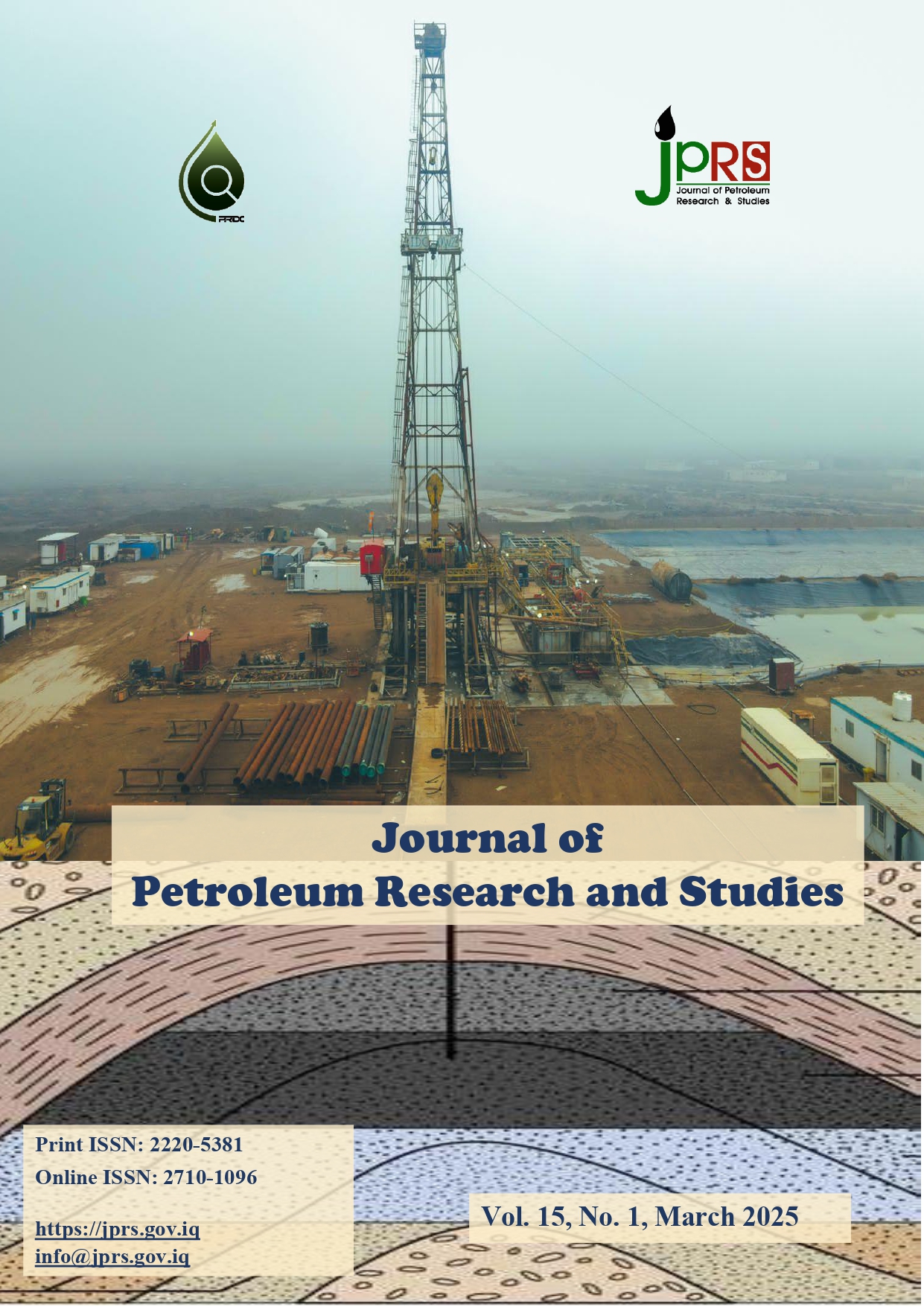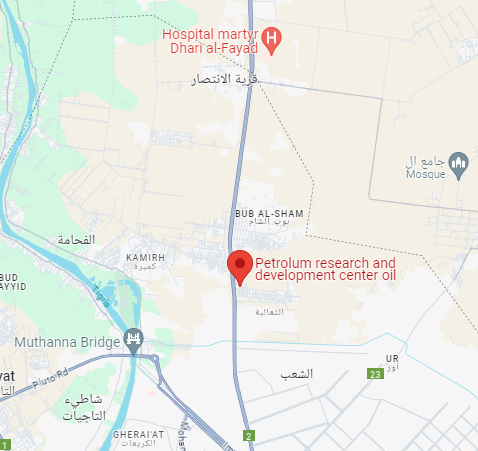تعزيز إنتاجية بئر نفط اندفاعي من خلال تقليل تدفقات المياه
DOI:
https://doi.org/10.52716/jprs.v15i1.827الكلمات المفتاحية:
Water inflow, water-oil ratio, well production, breakthrough in water, optimization, perforation, return on investment.الملخص
المشكلة المتعلقة بتدفق المياه تُعد واحدة من أبرز التحديات في صناعة النفط. تقدم هذه الورقة دراسات أُجريت في عام 2020 على البئر M.01 في حقل X، الذي واجه على مر السنين مشكلات مرتبطة بتدفق المياه، رغم أن إنتاجه الأولي لم يكن يعاني من مثل هذه المشكلات. الهدف الرئيسي من هذا البحث هو اقتراح حل عملي للحد من تدفقات المياه، مما يزيد من إنتاج النفط السطحي بطريقة فعالة من حيث التكلفة.
لتحقيق ذلك، تم إجراء تحليل عُقدي (Nodal Analysis) لتقييم أداء البئر من حيث تدفق السوائل (الماء والنفط). تم استخدام سجلات الإنتاج لتحديد منطقة التشبع الجديدة بالنفط، حيث تم عمل ثقوب جديدة. وأُجري تقييم اقتصادي باستخدام منحنى التنبؤ بتراجع الإنتاج. تم التعامل مع البيانات السرية، بما في ذلك بيانات الإنجاز والخزان والسجلات والبيانات الاقتصادية، باستخدام برمجيات PIPESIM و EXCEL.
وفقًا للنتائج، كان سبب تدفق المياه في البئر M.01 كانت ناجمة عن إزاحة اتصال الماء بالنفط، نتيجة للاختراق الجزئي عبر ظاهرة المخروط المائي، ما أدى إلى انخفاض تدفق النفط من 3005.585 برميل نفط في اليوم (STB/d) إلى 241.9834 برميل نفط في اليوم.
لمعالجة هذه المشكلة، تم تنفيذ عملية تثقيب باستخدام أنابيب ملفوفة (Coiled Tubing) في منطقة التشبع بالنفط بنسبة 100%، وتم عزل المستويين باستخدام سدادة عبر تقنية الـ Slickline، أسفرت هذه العملية عن تدفق نفط بلغ 2931.087 برميل في اليوم، مع تدفق ماء بلغ 325.6764 برميل في اليوم.
بعد تحسين الإنتاج باستخدام منحنيات حساسية ضغط رأس البئر وتعديلات قطر خط التدفق، زاد تدفق النفط إلى 3872.435 برميل في اليوم، وانخفض تدفق المياه بنسبة 90%..
أشارت حسابات معدل التدفق الحرج إلى أن الإنتاج يجب ألا يتجاوز 5150 برميل في اليوم لتجنب اختراق الماء السريع، ومن المتوقع أن يظل مشروع التثقيب في منطقة تشبع النفط فقط لإنتاج مثالي مربحًا لمدة 11 عامًا، مع عائد على الاستثمار خلال سنة واحدة و7 أشهر و8 أيام.
المراجع
C. Cabot, “Covid-19 et marché de l’électricité: quelles conséquences à long terme?,” Le grand continent, 2020.
H. Marciot, “L'Europe manquera-t-elle d'électricité?,” Le grand continent, 2020.
B. McWilliams, S. Tagliapietra, and G. Zachmann, “The energy crisis represents the greatest systemic risk for Europe today,” Le Monde, 2022.
G. Sgaravatti, S. Tagliapietra, and G. Zachmann, “Adjusting to the energy shock: the right policies for European industry,” Bruegel Policy Brief 11/23, pp. 1-21, 2023.
D. Lincot, “Energie solaire photovoltaïque et transition énergétique,” Collège de France, Leçons inaugurales, Open Edition Books, 2022.
S. John, Forecasting Oil and Gas Producing for Unconventional Wells, 2nd ed., Petro, Denver, 2018.
R. G. Miller and S. R. Sorrell, “The future of oil supply,” physical and engineering sciences, vol. 372, pp. 20130179-20130205, 2014. DOI: https://doi.org/10.1098/rsta.2013.0179
V. Belomo, M. Nitcheu, E. D. Dongmo, K. Njeudjang, G. Kuiatse, and S. Kingni Takougang, “Activation of a non-erruptive well by using an electric submersible pump to optimize production,” Petrovietnam Journal, vol. 6, pp. 36-42, 2022. DOI: https://doi.org/10.47800/PVJ.2022.06-04
R. M. Kamga Ngankam, E. D. Dongmo, M. Nitcheu, J. F. Matateyou, G. Kuiatse, and S. Kingni Takougang, “Production step-up of an oil well through nodal analysis,” Journal of Engineering, vol. 2022, pp. 1-8, 2022. DOI: https://doi.org/10.1155/2022/6148337
K. Aminian, “Water production problems and solutions-Part I,” Petroleum & Natural Gas Engineering Department, West Virginia University, 2003.
R. R. Rodney and D. K. Robert, “Produced water and associated issues,” Oklahoma geological survey, report 6-2003, 2003.
R. S. Seright, R. H. Lane and R. D. Sydansk, “A Strategy for Attacking Excess Water Production,” SPE Prod & Fac, vol. 18, no. 3, pp. 158-169, 2003. https://doi.org/10.2118/84966-PA
M. Armenta, “Mechanisms and control of water inflow to wells in gas reservoirs with bottom-water drive,” Theses, Louisiana State University and Agricultural & Mechanical College, 2003.
N. Kolher, J. Lessi and R. Tabary, “Successful application cases of water control treatments in Russia,” Oil and Gas Science and Technology, IFP 1995.
L. Seright, “A strategy for attacking excess water production,” SPE 70067, pp. 25-50, 2001.
J. C. Karp, D. K. Lowe and N. Marusov, “Horizontal barriers for controlling water coning,” J Pet Technol, vol. 14, no. 7, pp. 783–790, 1962. https://doi.org/10.2118/153-PA
A. Taha and M. Amani, “Overview of water shutoff operations in oil and gas wells; chemical and mechanical solutions,” Chem. Engineering, vol. 3, no. 2, 51, 2019. https://doi.org/10.3390/chemengineering3020051
B. Fateh, “Etude des problèmes de venues d'eau dans l'huile,” p. 55-63, 2012.
A. Khashayar, “Water production problems and solutions,” Petroleum and natural gas engineering department, p. 15-30, 2003.
B. Bailey, M. Crabtree, J. Tyrie, J. Elphick, F. Kuchuk, C. Romano, and L. Roodhart, “Water control,” Oilfield Review, vol. 12, no. 1, pp. 31-53, 2000.
Y. Ould-amar, S. Chikh and H. Naji, “Attenuation of water coning using dual completion technology,” Journal of Petroleum Science and Engineering, Vol. 45, no. 1–2, pp. 109-122, 2004. https://doi.org/10.1016/j.petrol.2004.04.004
B. R. Reddy and L. Eoff, “Design Considerations for Oil-Based, Squeeze Cement Slurries to Prevent Unwanted Fluid Production: Methods of Slurry Performance Evaluation and Potential Formulation Improvements,” Paper presented at the SPETT 2012 Energy Conference and Exhibition, Port-of-Spain, Trinidad, SPE-158065-MS, 2012. https://doi.org/10.2118/158065-MS
C. Deolarte, R. Zepeda, V. Cancino, F. Robles and E. Soriano, “Design Considerations for Oil-Based, The History of Hydrocarbon-Based Ultrafine Cement Slurry System for Water Shutoff in Offshore Mexico,” Paper presented at the Offshore Technology Conference-Asia, Kuala Lumpur, Malaysia, OTC-24949-MS, 2014. https://doi.org/10.4043/24949-MS
G. Burrafato, E. Pitoni, D. Perez and S. Cantini, “Water Control in Fissured Reservoirs–Diagnosis and Implementation of Solutions: Cases from Northern Italy,” Paper presented at the SPE Offshore Europe Oil and Gas Exhibition and Conference, Aberdeen, United Kingdom, 2005. https://doi.org/10.2118/96569-MS
A. Sourget, A. Milne, L. Diaz, E. Lian, H. Larios, P. Flores and M. Macip, “Waterless Cement Slurry Controls Water Production in Southern Mexico Naturally Fractured Oil Wells,” Paper presented at the SPE International Symposium and Exhibition on Formation Damage Control, Lafayette, Louisiana, USA, 2012. https://doi.org/10.2118/151646-MS
L. Hernandez-Solana, J. Tellez-Abaunza and B. Garcia-Montoya, “Conformance Solution Improved Oil Recovery in a Naturally Fractured Carbonate Well,” Paper presented at the SPE Improved Oil Recovery Conference, Tulsa, Oklahoma, USA, SPE-179534-MS, 2016. https://doi.org/10.2118/179534-MS
E. O. Muñoz Mazo, C. L. Delgadillo Aya, C. Espinosa Leon, A. Rueda Lizarazo, L. Toro Agudelo, A. M. Naranjo Pacheco, ... & E. J. Manrique Ventura, “Multilateral Wells to Control Water Inflow in Reservoir Connected to Active Underlying Aquifers: A Technical and Economic Analysis”, In SPE Latin America and Caribbean Petroleum Engineering Conference, Port of Spain, Trinidad and Tobago, June 2023. https://doi.org/10.2118/213111-MS
A. Almasri, A. Abdulhalim, M. Al-Gaiar, and M. Farahat, "Enhancing Productivity, Optimizing Well Flow and Reducing Costs of Long Dual Lateral Oil Well Using Integrated Multilateral Drilling and Smart Completions Technologies Coupled with Inflow Control Devices: Best Practices, Lessons Learned, and Value Added." Paper presented at the GOTECH, Dubai, UAE, May 2024. https://doi.org/10.2118/219206-MS
H. Izadi, J. Y. Leung, M. Roostaei, M. Mahmoudi, J. Stevenson, A. Tuttle, C. Sutton, R. Mirzavand, and V. Fattahpour, “A practical workflow to design inflow control devices in SAGD projects to increase production and lower fresh water usage”, Fuel, vol. 356, 129454, 2024. https://doi.org/10.1016/j.fuel.2023.129454
D. Kherroubi, Z. Cristea, S. S. Alshehhi, H. M. Douik, R. Celma, O. A. Alawadhi, and R. Albarracin, "Application of Autonomous Inflow Control Valve (AICV) Technology to Enhance Oil Production and Reduce Unwanted Water Production: Case Studies," Paper presented at the SPE Water Lifecycle Management Conference and Exhibition, Abu Dhabi, UAE, March 2024. https://doi.org/10.2118/219043-MS
التنزيلات
منشور
كيفية الاقتباس
إصدار
القسم
الرخصة
الحقوق الفكرية (c) 2025 Myrille R. N. Evodo, Dianorré T. Ngatcha, François Ntep, Noel N. Kibanya

هذا العمل مرخص بموجب Creative Commons Attribution 4.0 International License.














